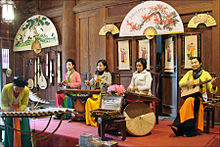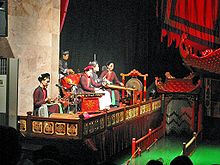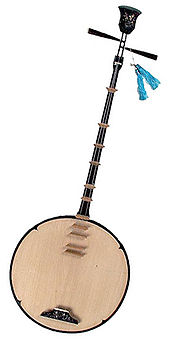- Music of Vietnam
-
Music of Southeast Asia  Brunei
Brunei
 Cambodia
Cambodia
 East Timor
East Timor
 Indonesia
Indonesia
 Laos
Laos
 Malaysia
Malaysia
 Myanmar
Myanmar
 Philippines
Philippines
 Singapore
Singapore
 Thailand
Thailand
 Vietnam
Vietnam Performance of Ca trù, an ancient genre of chamber music from northern Vietnam, inscribed by UNESCO as an Intangible Cultural Heritage in 2009
Performance of Ca trù, an ancient genre of chamber music from northern Vietnam, inscribed by UNESCO as an Intangible Cultural Heritage in 2009
Traditional Vietnamese music is highly diverse and syncretistic, combining native and foreign influences. Throughout its history, Vietnam has been heavily impacted by the Chinese musical tradition, as an integral part, along with Korea, Mongolia and Japan.[1] The ancient Indochinese kingdom of Champa also had an historical effect upon this music, because the Vietnamese court found it intriguing. However, even with these foreign influences, Vietnam has a unique musical tradition stemming from its native roots.
Contents
Imperial court music
Nhã nhạc is the most popular form of imperial court music, specifically referring to the court music played from the Trần Dynasty to the very last Nguyễn Dynasty of Vietnam, being synthesized and most highly developed by the Nguyễn emperors. It is based on earlier Vietnamese imperial court music, its primary influences coming from Ming Dynasty's imperial court and later the music of Champa. Along with nhã nhạc, the imperial court of Vietnam in the 19th century also had many royal dances which still exist to this day. The theme of most of these dances is to wish the kings longevity and the country wealth.
Classical music is also performed in honour of gods and scholars such as Confucius in temples.
Folk music
Vietnamese folk music is extremely diverse and includes dân ca, quan họ, hát chầu văn, ca trù, hò, and hát xẩm, among other forms.
Chèo
Chèo is a form of generally satirical musical theatre, often encompassing dance, traditionally performed by peasants in northern Vietnam. It is usually performed outdoors by semi-amateur touring groups, stereotypically in a village square or the courtyard of a public building, although it is today increasingly also performed indoors and by professional performers.
Xẩm
Xẩm or Hát xẩm (Xẩm singing) is a type of Vietnamese folk music which was popular in the Northern region of Vietnam but is considered nowadays an endangered form of traditional music in Vietnam. In the dynastic time, xẩm was generally performed by blind artists who wandered from town to town and earned their living by singing in common place.
Quan họ
Quan họ (alternate singing) is popular in Hà Bắc (divided into nowadays Bắc Ninh and Bắc Giang Provinces) and across Vietnam; numerous variations exist, especially in the Northern provinces. Sung acappella, quan họ is improvised and is used in courtship rituals.
Hát chầu văn
Hát chầu văn or hát văn is a spiritual form of music used to invoke spirits during ceremonies. It is highly rhythmic and trance-oriented. Before 1986, the Vietnamese government repressed hát chầu văn and other forms of religious expression. It has since been revived by musicians like Phạm Văn Tỵ.
Nhạc dân tộc cải biên
Nhạc dân tộc cải biên is a modern form of Vietnamese folk music which arose in the 1950s after the founding of the Hanoi Conservatory of Music in 1956. This development involved writing traditional music using Western musical notation, while Western elements of harmony and instrumentation were added. Nhạc dân tộc cải biên is often criticized by purists for its watered-down approach to traditional sounds.
Ca trù
Ca trù (also hát ả đào) is a popular folk music which is said to have begun with Ả Đào, a female singer who charmed the enemy with her voice. Most singers remain female, and the genre has been revived since the Communist government loosened its repression in the 1980s, when it was associated with prostitution.
Ca trù, which itself has many forms, is thought to have originated in the imperial palace, eventually moving predominantly into performances at communal houses for scholars and other members of the elite (this is the type of Ca trù most widely known). It can be referred to as a geisha-type of entertainment where women, trained in music and poetry, entertained rich and powerful men.
Hò
"Hò" can be thought of as the southern style of Quan họ. It is improvisational and is typically sung as dialogue between a man and woman. Common themes include love, courtship, the countryside, etc. "Hò" is popular in Cần Thơ - Vietnam.
Ritual music
- Nhạc đám ma - funeral music
- Nhạc lễ - ritual music
1940s -1980s
The Vietnam War, the consequent Fall of Saigon, and the plight of Vietnamese refugees gave rise to a collection of musical pieces that have become "classical" anthems for Vietnamese people both in Vietnam and abroad. Notable writers include Pham Duy and Trinh Cong Son. Singers include Khanh Ly and Le Thu.
Modern music
In Vietnam, there is no official music chart across the country or digital sale.
Pop music
The embrace of Modern Pop music culture has increased, as each new generation of people in Vietnam has become more exposed to and influenced by westernized music along with CJK's fashion style. Musical production has improved and expanded over the years as visiting performers and organizers from other countries have helped to stimulate the Vietnamese entertainment industry. Such performances include international stages like the Asia Music Festival in South Korea where popular Vietnamese singers such as Ho Quynh Huong, My Tam, Ho Ngoc Ha, Lam Truong, and others have performed along with other singers from different Asian countries. During the recent years such as 2006 and beyond, Vietnamese pop music has tremendously improved from years past. With the help of the Internet and sites such as Zing, Vietnamese music has been able to reach to audiences nationally and also overseas. There are many famous underground artists such as Andree Right Hand, Big Daddy, Shadow P (all featured in a popular song called De Anh Duoc Yeu) and countless others who have risen to fame through the Internet. In addition, there are also other singers that have gone mainstream such as M4U, Ho Ngoc Ha, Bao Thy, Wanbi Tuan, Tu Quynh, Radio Band, etc. There are also amateur singers whose songs have been hits in Vietnam such as Thuy Chi. These singers tend to view singing as a hobby, therefore not being labeled as a mainstream artist. Overall, the quality of recording and the style of music videos in Vietnam has improved a lot compared to the past years due to many private productions and also overseas Vietnamese coming back to produce a combination of Western and Vietnamese music.
Rock and heavy metal
Traditional musical instruments
- Đàn bầu (monochord zither)
- Đàn gáo (two-stringed fiddle with coconut body)
- Đàn nguyệt (two-stringed fretted moon lute)
- Đàn nhị (two-stringed fiddle with hardwood body)
- Đàn sến (two-string fretted lute)
- Đàn tam (fretless lute with snakeskin-covered body and three strings)
- Đàn tam thập lục (hammered dulcimer)
- Đàn tranh (long zither)
- Đàn tỳ bà (pear-shaped four-stringed fretted lute)
- Kèn bầu (oboe)
- T'rưng (bamboo xylophone)
- K'ni (also spelled k'ny or k'ný) - one-string vertical fiddle with a resonating disc that is held in the player’s mouth; played by the Jarai people of the Central Highlands
See also
- Culture of Vietnam
- History of Vietnam
- Nhạc tài tử
- Traditional Vietnamese dance
- Traditional Vietnamese musical instruments
- Vietnamese theatre
References
- ^ "Southeast Asian arts Vietnam". Encyclopædia Britannica Online. Encyclopædia Britannica. 23 July 2008. p. 36. http://original.britannica.com/eb/article-29500/Southeast-Asian-arts.
External links
- BBC Radio 3 Audio (60 minutes): Tran Quang Hai in Hanoi. Accessed November 25, 2010.
- BBC Radio 3 Audio (60 minutes): Tran Quang Hai in Saigon. Accessed November 25, 2010.
- (French) Audio clips: Traditional music of Vietnam. Musée d'Ethnographie de Genève. Accessed November 25, 2010.
- Listen to traditional Vietnamese music
- The traditional music of Vietnam
- Traditional music of Vietnam from Vietnam-Culture.com
- International Institute For Vietnamese Performing Art (IIVPA)
- Encyclopedia of Vietnamese music
- Prosperity revives a tradition (Vietnam's live music for the dead) by Ho Binh Minh, Sunday April 18, 04:22 AM
- VietnamTourism.com: Traditional Theatre
- Vietnamese Institute of Musicology
- England based Vietnamese music community site
- Việt Nam Cultural Profile - detailed overview of different music genres plus directory of key contacts
- Young Vietnamese pop culture music Da Nhat Yen
- Music of the Montagnards of Vietnam, part 1 - a panorama of tribal music in Vietnam by Tran Quang Hai
- Music of the Montagnards of Vietnam, part 2 - a panorama of tribal music of Vietnam by Tran Quang Hai
- Music of the Montagnards of Vietnam, part 3 - a panorama of tribal music of Vietnam by Tran Quang Hai
Listening
- UbuWeb Ethnopoetics: Ca Dao: Vietnamese Folk Poems
- Recording of Vietnamese folk singer Pham Duy at the 1966 Florida Folk Festival (made available for public use for the State Archives of Florida)
- Nhạc Truyền Thuyết Về Chú Mèo Ngủ Quên, the legend of the Cat-That-Sleeps.
Music of Asia Central Afghanistan · Badakhshan · Buryatia · Gansu · Kazakhstan · Khakassia · Kyrgyzstan · Mongolia · Tajikistan · Turkmenistan · Tuva · UzbekistanEast South Southeast Brunei · Burma · Cambodia · East Timor · Indonesia · Laos · Malaysia · Philippines · Singapore · Thailand · VietnamSouthwest Transcontinental Armenia · Azerbaijan · Cyprus · Egypt · Georgia (Ossetia) · Russia (Altai Republic · Sakha Republic) · TurkeyCategories:- Vietnamese music
Wikimedia Foundation. 2010.




